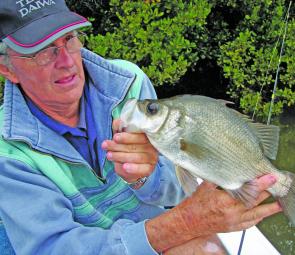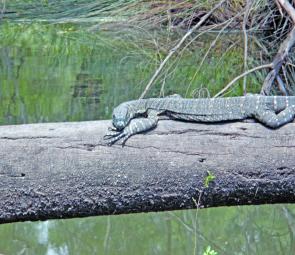I’m having a holiday locally this month to take advantage of the bass, school jew, snapper and flathead that highlight the good fishing available in here at this time of year.
There’s a fair chance I won’t be much interrupted by rain, either, unless something really is going wrong with the local climate; there’s usually only the odd southerly blow and the chance of a storm later in the month.
The rest of the time it’s progressively warmer morning starts, gradually earlier north-east sea breezes and some more than passable fun with lures. Luckily, daylight saving starts after the October weekend so the chooks won’t have to wake up any earlier.
This is a breeding month for flathead, with big females and their attendant harems of spiky male fish setting up love shacks along the deeper, sandy drop-offs and at the bases of rock walls in the lower Richmond from about Pimlico down to the bar.
It’ll pay to keep an eye on the temp gauge on the sounder when chasing these lizards. Early in the month, the water coming down the river will still be quite cool (especially in the mornings) and the ocean water will be relatively warmer, so an incoming tide will provide better results
Later in the month, or even on a hot day, as the river water warms to the low 20°s the ocean water will be relatively cooler and a falling tide will fire up the flatties.
Just remember that the big ones are for letting go to keep breeding, the smaller fish are for inviting home to dinner.
A 4” to 6” plastic or one of the larger TT Switchblades that should be hitting the shops soon will pick up flatties of all sizes.
Just make sure your leader (4kg to 10kg is fine) is up to the job and check it after each and every fish, regardless of size. Even the little spikers can peel shreds off a leader in no time.
Although some fishos swear that fluorocarbon is the most abrasion-resistant leader material, I’m sure there are nylon monofilaments that come very close, if they don’t indeed exceed fluoro.
Green Schneider Klear Line mono is some of the most abrasion-resistant leader material around, and especially in classes from around 6kg to 15kg is supple enough to take a good knot to join 6lb to 12lb braid.
If you can find it in clear, Stren Original is also fantastically abrasion-resistant. Stren Magnathin isn’t too bad while the new Stren Superknot Clear might also be interesting.
You’ll also be glad your leader was in tip-top condition if the ‘flattie’ you were jigging up starts tearing off at a very un-flattie-like rate of knots and you see your rod tip bobbing towards the water in time with the lurching head shakes you feel coming up the line.
There have been healthy numbers of school jewfish around the rocks, along the beaches and over the closer reefs during the cooler months but as the river comes to life they’re moving into the estuary in reasonable numbers.
Find the thickest concentrations of bait and there’s a strong chance that the nearest deep hole, reef or sheltered eddy will have a bunch of schoolies waiting for the tide to ease up so they can mosey on out and enjoy some fine seafood dining.
Schedule your trip to coincide with a tide that’s slackening off, changing and then barely quickening and you could well be in business. Use live herring, mullet, tailor if legal (30cm) or any number of soft plastics from 4” to 7”, vibrating blades or lipless crankbaits.
Bass and estuary perch make their way back up the system this month, with the perch setting up shop around the school prawns, roughly from Coraki to Wardell, and the bass steadily heading up towards Lismore and Casino and beyond.
The blossoming lilac of the jacaranda and the gold of the silky oak signify the peak of the freshwater season and both will be in full bloom before the end of October.
The Richmond is looking in quite good condition for the bass season with half-decent flows and acceptable water quality so let’s hope we see the weed growth to support aquatic life and enough rain to foster the bankside greenery that will allow terrestrial food to prosper.
Warmer afternoons mean more insect hatches and on those first few evenings when your nose recoils at that rank odour the kikuyu beetles put out as they emerge and take flight, you just know the bass are going to be smashing everything that lands on the surface.
But there’ll still be plenty of surface hits early in the morning, especially on walkers and fizzers cast around the herring schools, before the fish head back to the deeper snags as the sun climbs.
Back on the coast, the October inshore water is usually about as cool as it gets around here, with temps hovering around 18°.
Over the cooler months it’s easy for fleece-clad locals to play ‘spot the Victorian’ on the beaches – they’re the ones wearing only scraps of cloth and/or bits of string. It’s a bit the same in the water, where hordes of salmon frolic and cavort with mating on their minds.
It’s not all fun and games for the salmon, though: they’re quite often driven right into the shallows by pods of dolphins and most years about this time I see white pointers in close, too.
A couple of years ago I watched a gannet plunge into the sea less than 100m off the beach, only to rocket instantly from the water in a white shark’s jaws.
One morning just a week or so ago, I saw every detail of a white around 3m long surfing the unbroken face of the shore break a mere 25m away. I was on dry sand and still instinctively took a few spooky steps backwards!
Surf fishers chasing the last of the school jew and migrating flatties on the beaches and the first of the new season’s whiting and dart shouldn’t be wading across gutters at first or last light, that’s for sure.
Further out, snapper are still in spawning mode but are usually holding a little deeper. The warm current should be starting to run out wide and the eggs and fry will hitch a ride south.
Teraglin and pearl perch are also heading deeper with the best of the pearlies starting to mix it with the kingies and samson out in 40 fathoms-plus, although there should be still a few in closer.
The major thrust of the humpback whale southern migration comes this month, too. Be particularly wary of cows with calves and woe betides any boat that gets between mother and child.
Reads: 2292
Estuary perch are on the move this month as the school prawn populations head up the rivers as the salt water takes over the middle reaches.

It’s mildly entertaining when a water dragon shows an interest in your bass lure but when 1.5m of goanna drops in on a passing surface crawler, it’s Armageddon!




